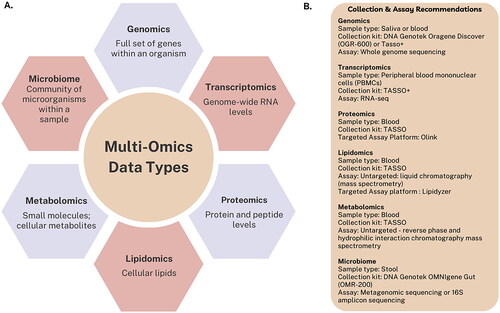Figures & data
Figure 1. Multi-Omics Data Types. (a) Common multi-omics data types include genomics (i.e., full set of genes within an organism), transcriptomics (i.e., genome-wide RNA levels), proteomics (i.e., protein and peptide levels), lipidomics (i.e., cellular lipids), metabolomics (i.e., small molecules; cellular metabolites), and microbiome (i.e., community of microorganisms within a sample). (b) Collection and assay recommendations. Note: This is not an exhaustive list of all possible sample types, collection kits, or assay methodologies, but rather, one option for each ome.

Figure 2. Longitudinal study design recommendations in stress and multi-omics research. (a) Studies beginning in the perinatal period should examine associations between maternal and child multi-omics and birth outcomes, growth, and cognitive and emotional development, including measures of maternal stress, diet, and social support. Parents should be surveyed for children’s adverse childhood experiences (ACEs). Monitoring environmental exposures in the home for two-week periods using exposome monitoring and parental surveys is recommended to give context to multi-omics analyses. Here, researchers have the power to examine trajectories of molecular change across the entire lifespan. (b) Studies of early childhood should pair multi-omics and analyses with developmental milestones of interest, and behavioral measures and tasks. Environmental exposure assessments should also include both home and school monitoring. Both parents and children should be surveyed about the child’s ACEs. (c) When examining the transition from adolescence to adulthood, associations between multi-omics and pubertal timing/transition, physical and mental health, and school performance should be assessed. Children can be asked to self-report psychological data, including ACEs. Parental surveys and environmental exposure assessments can be included to add additional context to analyses. (d) In any longitudinal studies occurring in adulthood, researchers should examine the stability of analytes across the study as they relate to stress, health, and disease, including interactions between ACEs and current stress levels on multi-omics and stress-related pathologies. Analyte change in response to experimental (e.g., social evaluation) stressors can be examined to provide insight into how stress response systems function. Researchers may also consider assessing analyte levels before and after immersive interventions to observe the molecular changes that occur during the transition from stress-related dysfunction to health. (e) In intensive longitudinal study designs, stress levels can be tracked multiple times per day, daily, or weekly, providing a higher-resolution assessment of current stress levels as well as the variability in these levels over time. These designs can be cost effective in that high numbers of repeated measures in stress observations can compensate for smaller overall sample size for multi-omics analysis (Moriarity & Slavich, Citation2023). Although adult populations are easier to recruit for these types of study designs, valuable gains could be made from intensive longitudinal designs which monitor the perinatal or childhood periods as well.

